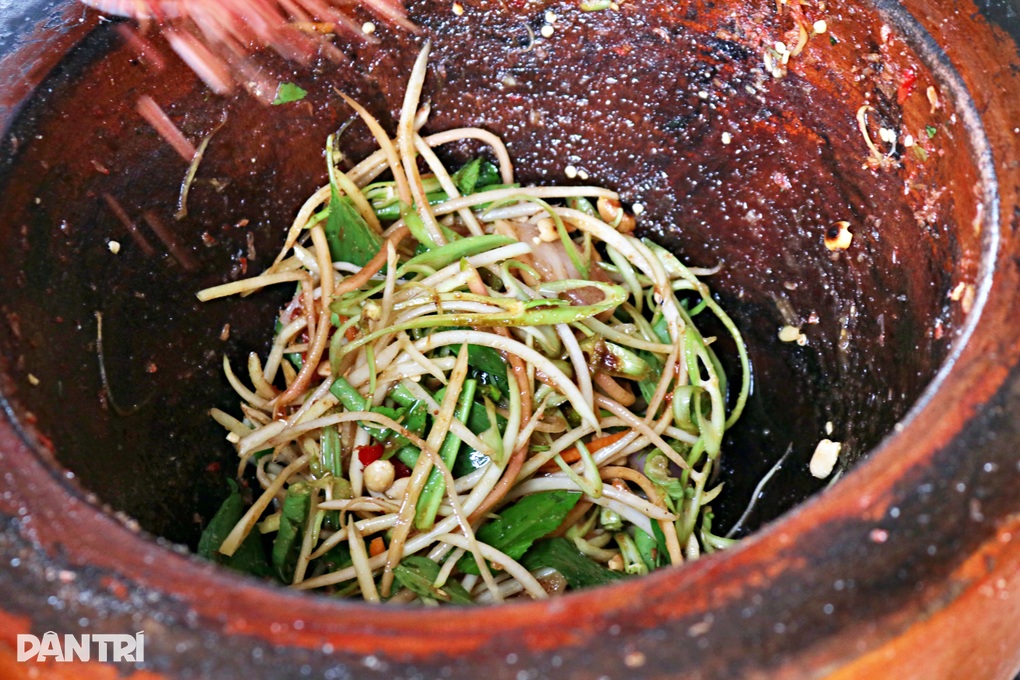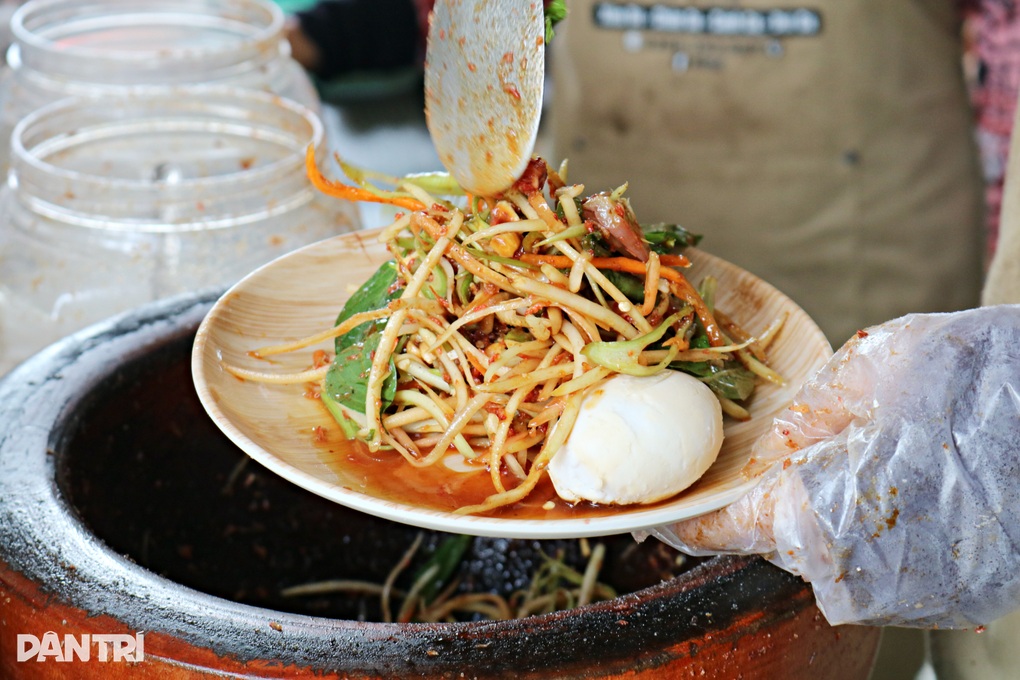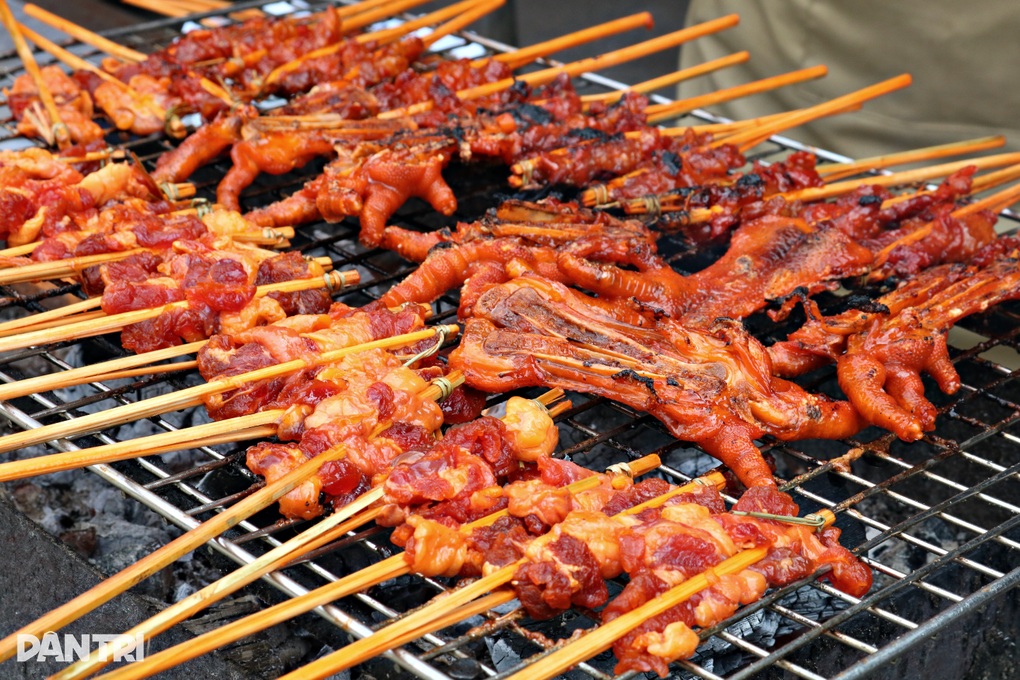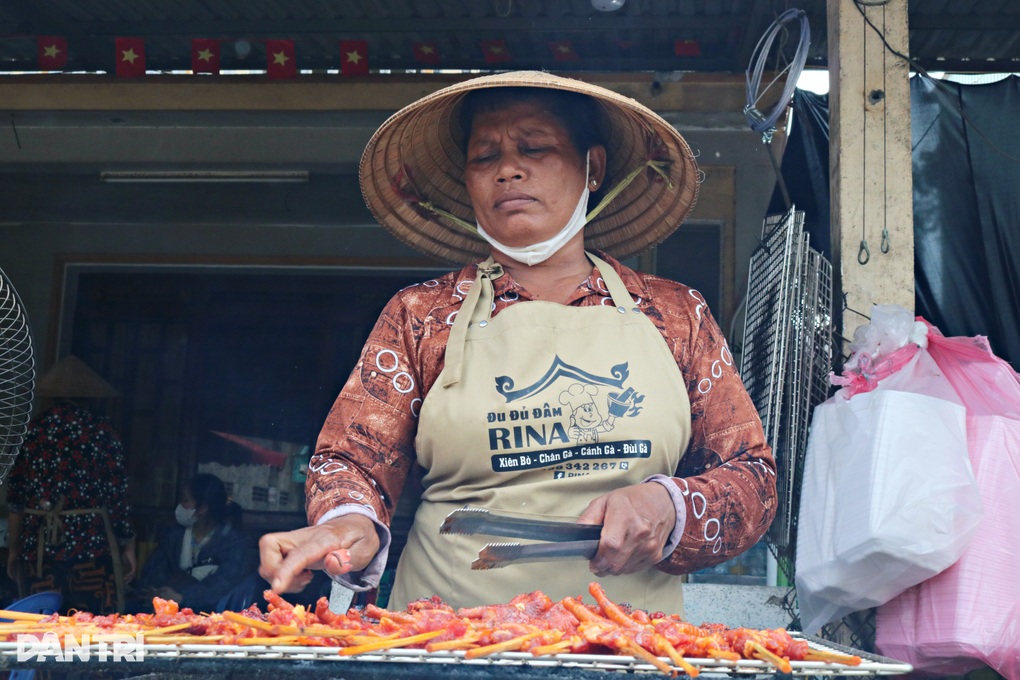Phnom Pi small village, Tri Ton mountainous commune, An Giang province, suddenly becomes a bustling destination every afternoon, attracting a large number of tourists just because of a unique street food: pickled papaya.
The popularity of this dish has gone beyond the small squirrel's scope, creating a culinary phenomenon on social networking sites.
The secret to getting rich in a small neighborhood
In just a stretch of less than 500m, there are more than 10 shops selling pickled papaya. Among them, Rina shop stands out and is introduced by locals as one of the first two shops selling this dish in Phnom Pi.

Mr. Dao Van Phung, 40 years old, a tourist from Can Tho , affirmed that this is a "must-try dish when coming to Tri Ton". Mr. Phung said that the street selling papaya salad is easy to find because the aroma of fish sauce and grilled beef spreads from the beginning of the street.
The owner, Néang Srây Ny, 30, a Khmer woman, shared that her family's papaya shop has been around for more than 20 years, opened by her mother after learning the recipe from a Cambodian immigrant.
The name "battered papaya" comes from the unique way of preparing it: instead of mixing the usual salad, people use a mortar and pestle to pound the ingredients so that the spices are evenly absorbed.
At first glance, Tri Ton papaya salad is easily confused with a Thai salad. However, Thai salads tend to be sour and spicy, while Khmer papaya salad is sweeter, more pleasant and easier to eat. The difference lies in the recipe, with the soul being a special Khmer-style fermented fish sauce, kept secret, creating a rich and distinctive aroma.

The preparation is meticulous but the main ingredients of this dish are very easy to find: shredded green papaya, green beans, green spinach, lemon, tomato, onion, pork floss, coriander and spices such as sugar, garlic, chili.
To make the salad authentic, the papaya chosen must be the yellow or pink "duckbill" type, shredded and then chilled with ice to keep it crispy. When preparing it, the owner will put the chilled papaya in a mortar, add the crab fish sauce, other ingredients and spices, then use a pestle to pound continuously but gently until the papaya is soaked with spices.
The finished papaya salad is served on a plate, sprinkled with peanuts and herbs. The harmonious combination of sour, spicy, salty and sweet flavors has created a street food that helps people earn extra income.
Mashed papaya is often served with mixed duck eggs – the type of egg whose white and yolk are mixed together to increase the fat content. Each duck egg costs 5,000 VND. Some diners eat 2-3 portions of salad, each serving using 3-4 duck eggs.
The attraction of the shop is clearly shown through the numbers. On normal days, the shop sells 200-300kg of fresh papaya per day, but on holidays or weekends, this number skyrockets, even reaching 400-500kg.
Each kilogram of fresh papaya will produce 4 to 6 portions of salad, with each portion costing 25,000 VND, the restaurant can earn tens of millions of VND in revenue each day thanks to this salad alone.

As the papaya salad became more popular, the locals started selling chicken wings, grilled chicken feet, and grilled frogs. But the most special dish is grilled beef – the second most popular dish after the papaya salad in Tri Ton.
The beef here is raised in Tri Ton, also known as Bay Nui beef, a purebred domestic breed, free-range, and fed on natural grass. The beef is tender, has a distinctive aroma and red color, making it a specialty of grilled beef throughout Tri Ton.
"During busy holidays, selling hundreds of papaya plates and hundreds of grilled beef skewers a day is normal," Ny revealed.

For grilled beef skewers, people often choose to cut the beef brisket, along with caul fat or entrail fat, marinate it, then sandwich it between split bamboo sticks and grill it over charcoal. The smell of grilled beef spreads throughout the street, creating the flavor of the specialty.
The boom of the papaya street food is not only limited to the culinary aspect, but also creates a significant economic value for Tri Ton land. Since this dish became widely known, the lives of local people have had many positive changes.

In addition to farming, Khmer people here have a stable source of income by providing ingredients, working at restaurants or selling the above dishes themselves.
From the shabby shops of a few years ago, businesses have now boldly invested and expanded their premises into more spacious shops, creating a wave of local tourism development.
Source: https://dantri.com.vn/du-lich/mon-goi-giup-ca-xom-lam-giau-o-mien-tay-hut-khach-toi-bien-gioi-an-thu-20250926235111581.htm




![[Photo] The 4th meeting of the Inter-Parliamentary Cooperation Committee between the National Assembly of Vietnam and the State Duma of Russia](https://vphoto.vietnam.vn/thumb/1200x675/vietnam/resource/IMAGE/2025/9/28/9f9e84a38675449aa9c08b391e153183)
![[Photo] High-ranking delegation of the Russian State Duma visits President Ho Chi Minh's Mausoleum](https://vphoto.vietnam.vn/thumb/1200x675/vietnam/resource/IMAGE/2025/9/28/c6dfd505d79b460a93752e48882e8f7e)

![[Photo] Joy on the new Phong Chau bridge](https://vphoto.vietnam.vn/thumb/1200x675/vietnam/resource/IMAGE/2025/9/28/b00322b29c8043fbb8b6844fdd6c78ea)
























































































Comment (0)